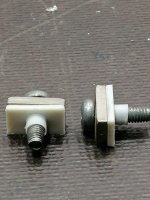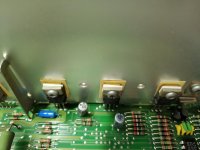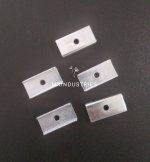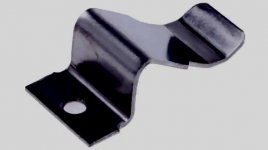Those are threaded?
80s...
Tedious to make, and Nylon can have moisture issues, degrades over time. And threads lose tension, can go loose.
Nylon has to be boiled in water or oil so as to stabilize it. Otherwise dimensions change with ambient conditions, and it gradually disintegrates.
Making the threads would need tapping, or an unscrewing mold, both are costly in terms of production.
So it went out of favor.
Rectangular washers may be available.
Sheet metal nuts are also available, the nut is attached to larger bit of metal, sometime welded, sometimes in a cage, those may be a better way to distribute the force.
80s...
Tedious to make, and Nylon can have moisture issues, degrades over time. And threads lose tension, can go loose.
Nylon has to be boiled in water or oil so as to stabilize it. Otherwise dimensions change with ambient conditions, and it gradually disintegrates.
Making the threads would need tapping, or an unscrewing mold, both are costly in terms of production.
So it went out of favor.
Rectangular washers may be available.
Sheet metal nuts are also available, the nut is attached to larger bit of metal, sometime welded, sometimes in a cage, those may be a better way to distribute the force.
Last edited:
They shouldn´t be threaded, you need bolt to pass through freely and engage on a thread at the other end, so as to compress metal_washer/ nylon_washer_nipple/transistor flange/mica/heatsink together
The part is trivial to make commercially, first punch hole, then cut rectangle from strip, mkaybe if needed give it an extra punch btween two flat surfaces to flatten it.
A progressive die set can make 3000-5000 of those an hour.
And then you galvanize them in a rotary tank in 30 to 100kg lots, very cheap.
The part is trivial to make commercially, first punch hole, then cut rectangle from strip, mkaybe if needed give it an extra punch btween two flat surfaces to flatten it.
A progressive die set can make 3000-5000 of those an hour.
And then you galvanize them in a rotary tank in 30 to 100kg lots, very cheap.
The plastic part in the photo seems to be the threaded nut also, no metal nut is seen. Or maybe the washer is the nut, he as assembled it wrongly.
Which explains my long post above.
The sheet metal way is easier, and like you said, production rates can be high.
Galvanizing means hot dip here, electroplating is what you seem be to meaning.
Zinc chromate is cheapest, then bright zinc.
Which explains my long post above.
The sheet metal way is easier, and like you said, production rates can be high.
Galvanizing means hot dip here, electroplating is what you seem be to meaning.
Zinc chromate is cheapest, then bright zinc.
Last edited:
NO...I've seen these before, the washer isn't threaded. It's the same as any other TO-220 mounting hardware except it is rectangular instead of round. The washer spreads the force more evenly, and the nylon washer is only an insulator that prevents the screw and the washer from causing a short at the transistor tab, no threads.
Mike
Mike
Yes, either threaded heat sink or screw is longer and uses a regular nut on the other side.
Pressure will always be between screw head an nut,so it must be the farthest element.
And yes, by Galvanizing I mean by electrical means, which is THE most used method today, molten metal type is almost unheard of.
Real Chromate processes are frowned upon or plain forbidden, what´s sold under that name is actually Zinc, which can be passivated in 2 different baths, either "blue" or "chromate colour".
I use both for my speaker frames.
Pressure will always be between screw head an nut,so it must be the farthest element.
And yes, by Galvanizing I mean by electrical means, which is THE most used method today, molten metal type is almost unheard of.
Real Chromate processes are frowned upon or plain forbidden, what´s sold under that name is actually Zinc, which can be passivated in 2 different baths, either "blue" or "chromate colour".
I use both for my speaker frames.
These mounting kits were a vain attempt at reducing the **** poor case to sink thermal resistance of the TO-220. They do allow more pressure on the tab than traditional round washers, but increased pressure on the tab in a location away from the die doesn’t necessarily improve the situation. The tab can deform, resulting in more voiding under the actual heat source. There is a max torque spec for a TO-220 for that reason. The TO-247 and 264 are better about that because the package is more rigid - more pressure on the mounting hole does translate to more pressure directly under the die.
If you need more that 20 watts of average dissipation from a TO220, you really need to straddle a bar clamp across two, directly over the body of the package. Most class AB audio amps using TO-220’s won’t dissipate enough to worry about this. But class D and switch mode supplies can. In applications where they run To-247’s IGBTs at 100 watts of average dissipation (eg, solar inverters), they too can benefit from the improved mounting. They even make a TO-247 variant that doesn’t have a hole.
If you need more that 20 watts of average dissipation from a TO220, you really need to straddle a bar clamp across two, directly over the body of the package. Most class AB audio amps using TO-220’s won’t dissipate enough to worry about this. But class D and switch mode supplies can. In applications where they run To-247’s IGBTs at 100 watts of average dissipation (eg, solar inverters), they too can benefit from the improved mounting. They even make a TO-247 variant that doesn’t have a hole.
While we are talking about this, how many people check how flat the tab is to make good contact. That is for all trannies up to a TO264. I have seen some people flat them on a piece of glass with fine sandpaper, I have never done it. A specific guy loving Maplin amps once gave me a super S##t idiot stupid answer when I asked this a long time ago ! I have never tried it and are not sure how secure those tabs are. All is in vain if you have a wobbly tab that is not completely flat and not able to dissipate the heat. Then again as wg-ski said, it depends on the power dissipation requirement.
I have never tried it and are not sure how secure those tabs are. All is in vain if you have a wobbly tab that is not completely flat and not able to dissipate the heat. Then again as wg-ski said, it depends on the power dissipation requirement.
That’s why I prefer the spring loaded device clamps rather than using the device hole, gives a better clamp pressure centrally where it matters rather than just clamping one end of the device.
Doesn’t need a special heat sink with slots either.
Also is continuously putting the same pressure on.
THFM1 | Heatsink Retaining Spring for use with TO-218, TO-220, TO-247, TO-264 | RS Components
Doesn’t need a special heat sink with slots either.
Also is continuously putting the same pressure on.
THFM1 | Heatsink Retaining Spring for use with TO-218, TO-220, TO-247, TO-264 | RS Components
Attachments
I'd like to find these in the USA. Any clues would be welcome.
https://www.arrow.com/en/products/t...ips&utm_campaign=arrow_2021&utm_content=bnl_2
- Home
- Design & Build
- Parts
- Nylon insulation washers



